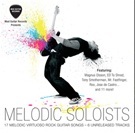String Skipping Tapping Étude: Added Tone Arpeggio Ideas Over 3 Octaves
 The Technique
The Technique
Essentially what you are doing is tapping one note with the right hand and then hammering on 3 notes with your left hand. The left hand fingering will either use fingers 1, 2 and 4 or fingers 1, 3 and 4 but in each bar the shape is the same but moved up and down octaves. You can use whichever right hand finger you normally tap with – most people use their index or middle finger.
Muting
The hardest aspect of this etude is muting. It is very difficult to eliminate all of the string noise when using heavy gain and without using heavy gain it is difficult to have enough compression to make all the notes have a similar dynamic value. When hammering down your fingers try to do it hard and snappy while avoiding tension in your fingers. This becomes especially important the less gain you use so if you can hit each note hard and fast then it will be better to use less gain. If you use more gain then the compression will mean even the slightest brush of another string will create a lot of unwanted noise.
Remember:
• Hammer on hard with both hands
• Practice at a variety of tempos
• When tapping with left hand mute with right hand (fingers and palm)
• When tapping with right hand mute with left hand (fingers and palm)
• Find a suitable level of gain
The Theory
This progression is in the key of G minor and sounds best above 180bpm.
The chord progression is G5, D5, E♭5, B♭5, C5, A♭5, D, D and the arpeggios used are:
Gmadd2
D♭13(no 3rd)
E♭Maj7
B♭add9
Cmadd9
Aø
Dadd♭9
D♭9
.
The first chord is a minor add 9 chord which means it is a standard minor chord with the addition of the 2nd/9th interval of the key – in this case an A. The note adds a feeling I would perhaps describe as uncertain, anxious or woeful but how each person relates to a note is unique to their view of music and their experiences of it. Minor add9 chords are used a lot in epic film scores and are often used to convey a sense of dread. This has no doubt influenced the way I and many people use it.
The second chord is not really an arpeggio at all but if you had to notate it in chord form it would be D♭13(no 3rd), it is 4 consecutive notes which serves two purposes, the first being to not give away the tonality of the chord as major or minor, the second being to show that tapping is a technique that doesn’t have to be confined to arpeggios and can be used for scalar runs – the pinnacle of this idea would be for 8 finger tapping.
The third chord is E♭Maj7. Being chord VI in a minor progression (Chord IV in a major) this chord lends nicely to a number of extensions and is by far my favourite chord to play/compose over. In this example I’ve merely added a major 7th however adding a 9th also sounds very good and they are both used frequently in modern styles from pop to metal to jazz. This chord is also often played as a minor (usually as a major and then as a minor) as the minor third is an F♯ which of course is the ♯7th if the key was G harmonic or melodic minor. Being chord I of the Lydian mode you can add the ♯4th to create a very alien sounding aesthetic.
The fourth chord is an add9 chord however I feel the main purpose of the chord is to relieve the tension created in the previous chord and so I did not want to do anything too fancy with it. Adding a 9th is usually the first thing I will do when expanding most chords as I feel it always adds flavour. Most people (who are probably influenced/indoctrinated by jazz theory) will automatically go to add a 7th first but I feel that this is a bit too rash and doesn’t always sound good for the type of music I want to make.
The fifth chord is a minor add9 chord and is chord iv in a minor progression (chord ii in a major). This is a powerful chord which I’ve always admired for its ability to re-energise a standard or generic progression. You will most definitely want to use a minor arpeggio over this chord and you may want to add a 7th rather than (or in addition to) a 9th. You could also add the 6th (A in this case) to demonstrate the Dorian nature of the chord (it is the root chord of the Dorian mode) however I prefer to only add the 6th as a subtle passing note if I even add it at all because I don’t generally like my music sounding too modal.
The sixth chord I’ve decided to use a half diminished arpeggio over. You could use a full diminished of course but for the purposes of this idea it is easier to play a half diminished.
The seventh chord is chord V and since this fairly classical sounding progression has reached its end, it is natural for the key to convert to harmonic minor and chord V to major. I’ve added a ♭9th as I feel this represents most of the tension which you encounter when playing a Phrygian Major scale over such a V chord. For the eighth chord, which is also another V chord (and being drawn out for extra tension) the chord has already been established as major and so I change the tapped D for a C to imply a D7 chord.
The great thing about these arpeggios is that they don’t sound like arpeggios. Tapping is a great technique to use – it is fast, efficient and relatively easy. The ability to use tapping for more than a flashy Eddie Van Halen style homage will make your playing immeasurably richer. Another great thing about these arpeggios is they don’t sound like scales. They take the tension invoked by close intervals of a scale and combine them with the wide open intervals found in arpeggios to exhibit the best of both worlds. Since the exercises in this étude are too fast to form any real sort of melody, the purpose of them will likely to be to create some intensity. You could start a solo with these ideas to create frantic ferocity right off the bat or you may want to start your solo with a melody and build up to be more energetic. I mostly use them to bridge the melodic gaps between short ideas and don’t often even use them for more than two or three beats. They are also good for getting up and down the fret board swiftly and I find myself relying on them more and more frequently during improvisation.
Variations
The variants in the variations tab I have included are generally a bit more awkward to mute and include arpeggios over 4 octaves. They indicate ways you could adapt this legato tapping concept to your own ideas.
As always, I hope this lesson has given you some ideas on how to pimp up your shred.
PDF Tab 1 | PDF Tab 2 (variations) | Guitar Pro Tab 1 | Guitar Pro Tab 2 (variations)
Good Luck!
Fraser
Fraser Edwards is the lead guitarist of Scottish power metal band Ascension. Their debut album Far Beyond The Stars is out now on Spiritual Beast/Universal Music You can also check Fraser’s personal website for additional guitar lessons.

















